The price of the currency is quite strong during the plunge. Let’s talk about Hyperliquid from the perspective of HIP, Vaults and Token models.

Reprinted from panewslab
02/09/2025·3days agoAuthor: Bai Ding & Shew, Xianrang GodRealmX
Since the Mentougou incident in 2014, corruption and market manipulation of centralized trading platforms have always plagued all participants in Crypto. After the FTX bankruptcy incident in 2022 completely sounded the alarm for people, people's attention to decentralized order book platforms has been significantly deepened. Well-known on-chain order book platforms such as dydx and Degate are all representatives of this type. While they have achieved remarkable results, , but due to policy and technical reasons, has not become a phenomenal platform.
At the end of 2024, Hyperliquid, launched by Jeff Yan 's team, who specializes in quantitative transactions , quickly became popular throughout Web3 with its product and marketing efforts, and attracted widespread attention. With TVL that is up to billions of dollars, Hyperliquid is expected to completely launch a new chapter in decentralized trading platforms and become a phenomenal application.
In the previous article "Interpretation of Hyperliquid Technology: Bridge Contracts, HyperEVM and its Potential Issues", we mentioned that Hyperliquid designed an application chain specially for high-performance order book systems and used this application chain on Arbitrum. Therefore, it was identified as "pseudo-Layer3" by L2BEAT. Currently, Hyperliquid has only 4 validator nodes, and the risk of bridge contracts is extremely high, which greatly sacrifices decentralization and security, but it also improves transaction matching efficiency and achieves a CEX-level user experience. Although controversial, this reflects the style of the Hyperliquid team:
At the beginning, we first focus on UX and fast user acquisition, even if doing so will bring safety risks. As the product volume reaches a certain level, it will gradually demine mines to solve decentralization and safety problems. This kind of project operation idea is common in high-performance infrastructure such as Solana and Optimism, and can often achieve good results in commercialization.
Similarly, Hyperliquid faces the same difficulties as other trading platforms: the cold start problem. The trading platform itself has a strong network effect, and "the more people you use, the easier it is to use", which makes the track very easy to control by oligarchs. Nowadays, it is extremely difficult to start the cold start of the new trading platform. Looking at the large proportion of Hyperliquid's airdrops and KOL matrix, it is not difficult to see that they have put a lot of effort into market operations.
But marketing campaign alone cannot make new trading platforms rise rapidly. There is undoubtedly a strong product as support behind this. Judging from Hyperliquid's design ideas at the product level, it is also focusing on the core purpose of "cold start". The author of this article will give an overview of Hyperliquid from the perspectives of HIP, Vaults and Token models to help everyone understand the design ideas behind this hot project in depth.
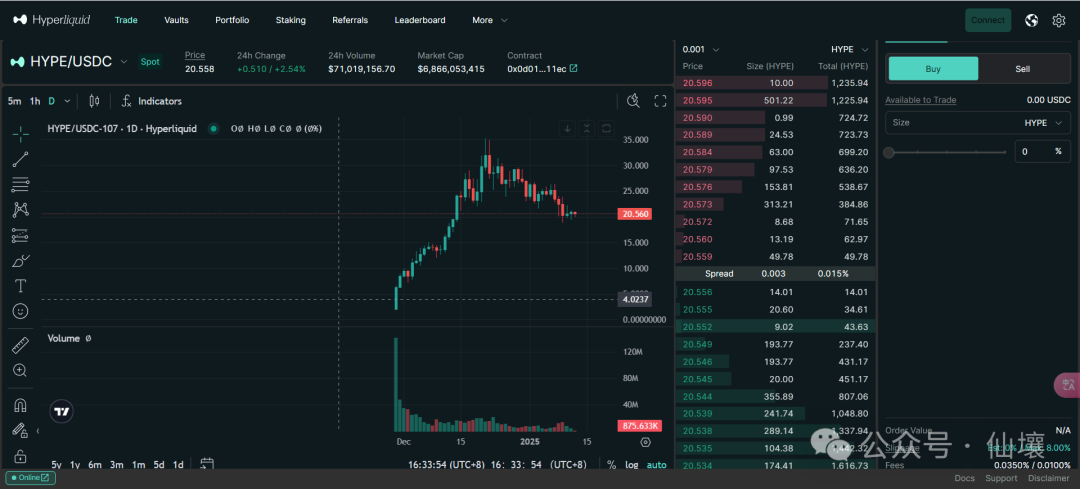
HIP-1 and HIP-2
Compared with Ethereum's EIP proposal, Hyperliquid named its proposal HIP and took the lead in introducing the two most important core HIPs for it: HIP-1 and HIP-2 to solve the listing and circulation of Tokens. question. Among them, HIP-1 mainly solves the token issuance and management solutions on the Hyperliquid chain, similar to Ethereum's ERC-20.
Here we can compare the Ethereum DEX's currency listing method. Most DEXs adopt AMM product model, and there are two steps to put the new token list:
1. First of all, the token developer must call the Mint function in the token contract that complies with the ERC-20 standard to define basic data such as token name, symbol, total supply.
2. After that, pair the newly minted token with another asset (such as ETH or USDT) and add it to the liquidity pool of DEX to provide initial liquidity. After that, people in the market will naturally act through arbitrage, SWAP, etc. Pricing tokens.
In Hyperliquid's system, the process of List tokens is much simpler. First of all, the Hyperliquid application chain is specially used for the order book system. If you issue new tokens on Hyperliquid through the HIP-1 standard, the system will directly help you create a trading pair between the new token and USDC. When you deploy a token contract, you can set a hyperliquidityInit parameter to determine how many tokens will be automatically injected into the order book market as initial liquidity. This way, there is no need to manually inject initial liquidity like in Ethereum AMM.
In this regard, the main function of HIP-2 is to use the above-mentioned initial liquidity to automatically make markets to solve the initial circulation problem of tokens.
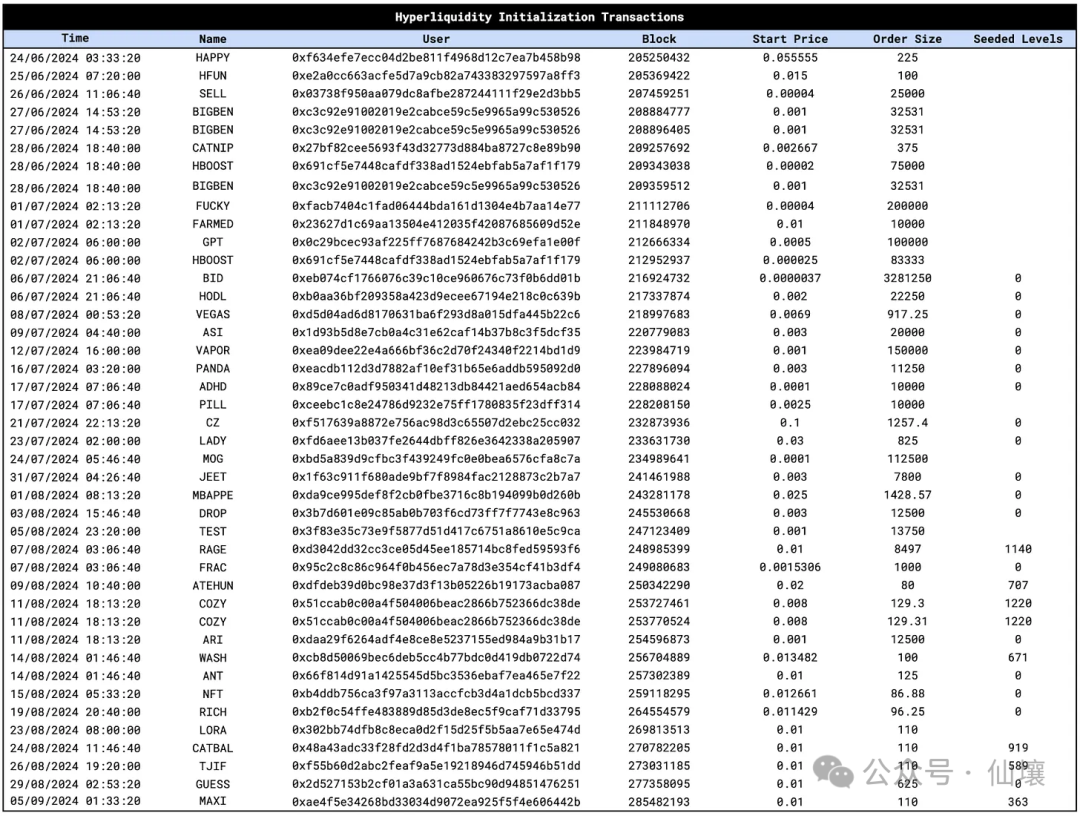
So what are the details of the HIP-2 automatic market making plan? Simply put, the solution proposed by HIP-2 is to conduct "linear market making" within a preset price range. Token deployers must first preset a price range, and then the Hyperliquid system will automatically publish a purchase and sale order based on this range to ensure that there is always liquidity in the market.
The details of this part mainly include three parts:
-
Set price range and order frequency: The token issuer must specify the upper and lower limits of the market making price, as well as the dividing point of the buy and sell orders. Each price point increases by 0.3% relative to the previous price point. This process will be updated every 3 seconds (or longer), ensuring that the system's pending orders always keep up with market fluctuations and avoid lag.
-
Order generation: When the price range is updated, HIP-2 will calculate how many orders should be placed at different price levels based on the spot quantity provided by the Token issuer.
-
Automatic reverse market making: Whenever a "full sell order" is completed, the system will automatically use the transaction funds (such as USDC) to place a reverse price limit payment order. In this way, there will always be new pending orders in the market to ensure that liquidity is always active.
Currently, there are two main ways to charge for general market makers on the market: the first is to charge a fixed monthly fee, and the second does not directly charge a monthly fee, but borrows a certain proportion of Token from the project party to make markets, usually 0.5% -1.5%. Of course, in order to prevent the token price from soaring and the repayment cost will increase sharply, market makers can change the charging method at any time, or repay the token at a pre-arranged price. This involves the game between the project party and the market makers. No description will be made due to space limitations.
Hyperliquid official reduces market making costs with the HIP-2 solution, and receives user deposits in a decentralized form for market making, which involves its module called Vaults, which we will introduce later.
HIP-1 and HIP-2 aim to significantly reduce the cost of coin listing and circulation of projects. HIP-1 ensures decentralization and transparency of currency listing. HIP-2 specifically provides "automatic market making" business for the order book system, allowing those project parties who lack market makers to do it with confidence on the spot order book platform. This has brought good reputation to Hyperliquid, but because Hyperliquid's current currency listing fee is too expensive, ordinary project parties will still be blocked from the threshold.
When it comes to the topic of currency listing fees, we must explain the Dutch shooting mechanism adopted by Hyperliquid. In the past six months, CEX has charged sky-high currency listing fees, and the controversial tokens and tokens have plummeted, with all kinds of fingers directly pointing to the centralization of its currency listing process. Against this background, the HIP-1 proposal stipulates that the Hyperliquid platform uses an open and transparent Dutch auction mechanism instead of the platform itself, thus gaining widespread favor.
In Hyperliquid's plan, every 31 hours is used as an "auction cycle", and one quota of listed coins is publicly auctioned within each cycle, and the annual quota of listed coins is limited to 280. At the beginning of each auction cycle, a new round of auction will begin twice the transaction price in the previous cycle. If the auction failed in the last cycle, the auction will start again from 10,000 US dollars this cycle. Due to the use of Dutch auctions, the auction price will drop step by step from the initial price until bidders who accept the selling price will gain the right to list the coins.
Compared with traditional CEX, Hyperliquid's currency listing mechanism is quite innovative, first of all, ensuring the openness and transparency of the currency listing process and avoiding human intervention and price manipulation. Secondly, this method completely handed over the decision-making power to the market, avoiding the insider of CEX personnel charging insiders. In December last year, Hyperliquid 's auction price was close to $1 million, which also made the lower-quality project parties have no financial resources to register, which directly avoided the spread of memecoin.
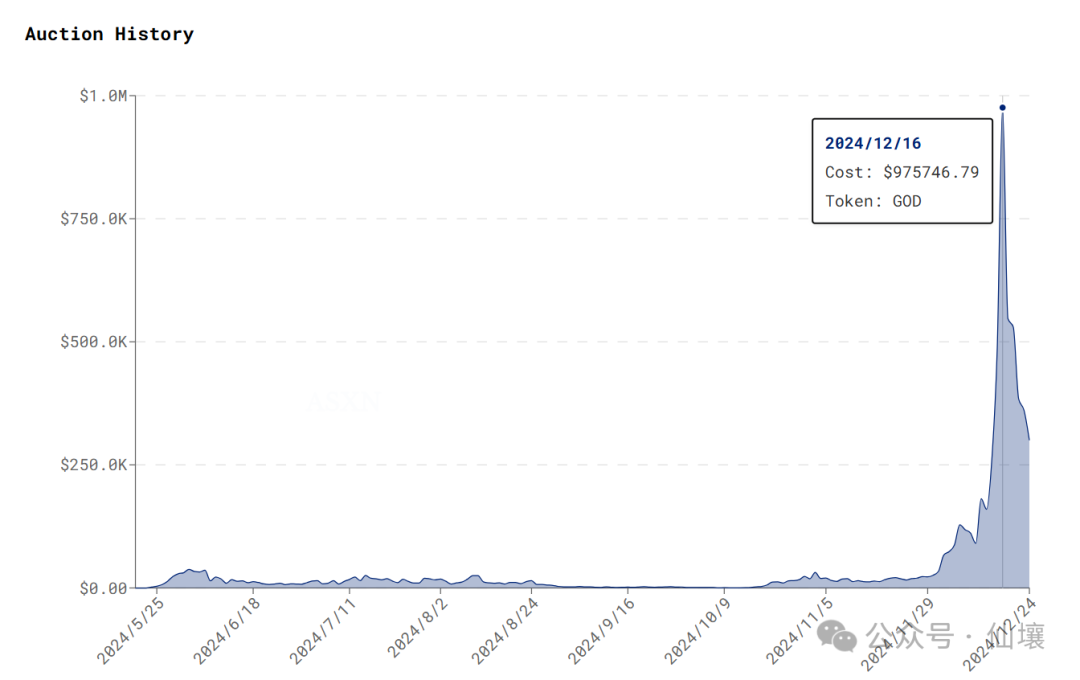
Source: ASXN Data
From the above we can see that the significance of HIP-2 is more about helping weak projects to quickly start cold and provide them with initial liquidity support, which also helps Hyperliquid as a trading platform to start cold. The Dutch auction method will hand over the right to list the currency to the market for pricing, which will be open and transparent throughout the process, which is a fair and just way. It can be said that Hyperliquid has indeed opened up a new model of order book trading platform. After it solves the security risks at the bottom of the application chain in the future, it is expected to become a phenomenal platform that can compete with Binance for the right to speak.
Vaults
Similar to traditional CEX platforms, Hyperliquid also has basic scenarios such as leverage and contract trading, and when it comes to contracts and leverage, it must have corresponding liquidation components. Hyperliquid provides a more decentralized approach in this regard and can participate in it. open form.
The Hyperliquid platform is called Vaults' core primitive, written at the bottom of the L1 chain. The market making and liquidation behaviors that occur on the Hyperliquid platform are operated by Vaults, and users can provide funds to Vaults and share the profits of market making or liquidation based on the share ratio. /loss.
Here we briefly explain that the maximum leverage multiple that each asset can support in Hyperliquid is different, ranging from 3 to 50 times. The specific calculation formula is as follows:

For example, if the maximum leverage multiple supported by an asset is 50 times, then according to the formula, the liquidation line is 1% of the initial margin, and if the maximum leverage of 3 times, the liquidation line is 16.7%. When the account net value is below the liquidation line, liquidation will be triggered. The liquidation methods can be divided into two types: order book liquidation and backup liquidation.
Order book liquidation means that if the net value of the trader's account falls below the liquidation line for the first time, the trader's position will automatically try to issue a market order instruction to the order book platform to close the position in full or partially, while the remaining collateral can still be owned by the trader. . Backup liquidation is that if the net value of the account falls below 2/3 of the liquidation line and the position is not processed in time through the order book liquidation method, Vaults will intervene in the backup liquidation, and at this time the trader's position and margin will be transferred to the liquidation People will not be returned to users. It can be said that Vaults is mainly responsible for backup liquidation in such scenarios, providing support for the Hyperliquid platform to prevent bad debts.
Currently, Vaults only supports the deposit of three stablecoin assets: USDC, USDT and USDC.e (cross-chain USDC).
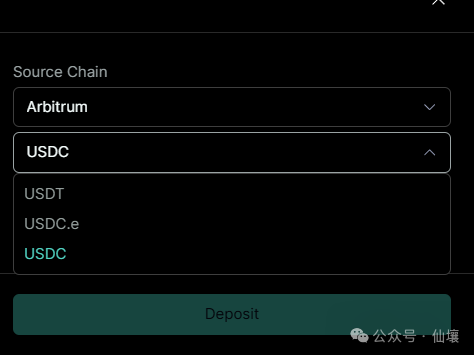
Source: Hyperliquid.xyz/vaults
From the perspective of income sources, there are three potential sources of income for Vaults participants. The first is market making returns, including short-term price fluctuations and the capital fee rate obtained by holding unilateral positions. The second is the return on orders. The person who eats orders in Hyperliquid will have to pay a transaction fee of 0.025, while the person who holds orders will receive a reward of 0.002% because of the liquidity provided. The third is liquidation income. When the position is lower than 2/3 of the liquidation line, the HLP liquidation vault can take over the position and make profits from it.
Depositing assets into Vaults is not a sure profit. On the one hand, market price fluctuations may lead to losses in market making strategies. On the other hand, after Vaults takes over the liquidation position, if the liquidation is not timely due to various reasons, or the assets to be liquidated sharply fall, it will lead to losses.
Currently, there are two original Vaults created by the official Hyperliquid team, namely the HLP vault responsible for market making and the Liquidator vault responsible for liquidation. In addition, anyone can create their own customized "User vault" on the Hyperquid chain. Develop your own quantitative strategy and become a "creator" and take the blame for your own profits and losses.
Of course, users can also join the official or other people’s Vault to become “followers”, which is a bit like the follower mode. Since the Vault creator needs to be responsible for managing the funds, he will receive a 10% profit share of the follower, but the proportion of assets that the creator injects into his own vault must always be greater than or equal to 5%, otherwise the withdrawal will be restricted.
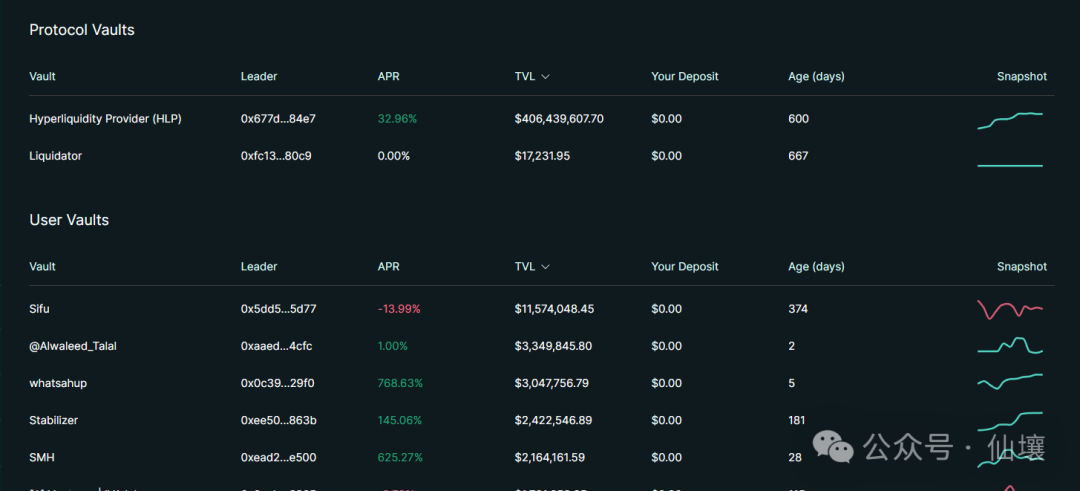
Vaults with different rates of return
It is still important to emphasize that as an emerging exchange, Hyperliquid's range of designs are designed to solve the cold start problem. The existence of Vaults means that the potential benefits of market making and liquidation are distributed to the community. According to Hyperliquid's official document, the purpose of doing this is to "de-platform", open up the power monopoly of CEX, and achieve democratization, but this is essentially a way to solve the cold start problem of trading platforms, just like using a The short checks attracted users and liquidity, not only solved the cold start problem, but also received positive reviews, killing two birds with one stone.
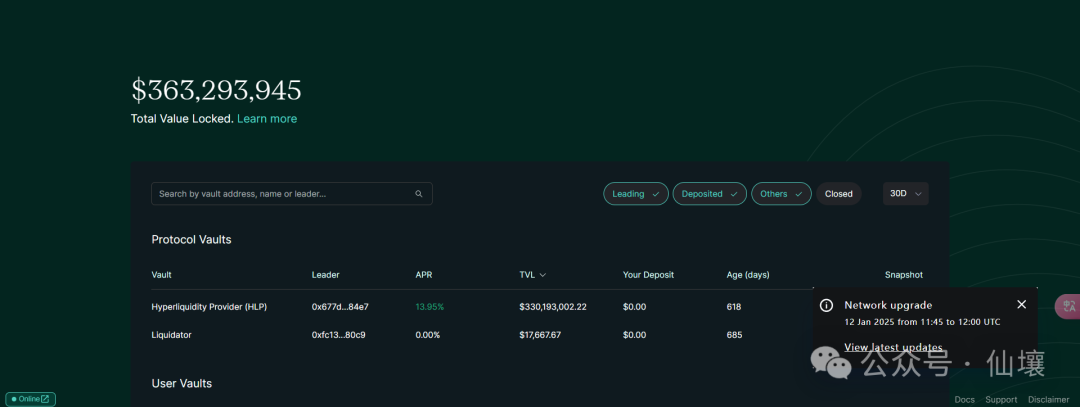
The market popularity has declined now, but Hyperliquid Vaults' TVL remains at hundreds of millions of dollars and has completed a cold start. Some of the Vaults' APR even reaches nearly 9,000%, which has a rich effect. But there is one problem that needs attention. Regarding how to ensure the security of funds deposited in the vault, the official does not currently disclose relevant information, which poses certain hidden dangers.
Token empowerment
Previously, Hyperliquid dropped 70% of $HYPE to the community, but $Hype did not show a significant selling pressure, but rose from $2 at TGE to about $30, which is inseparable from the strong empowerment of $HYPE. There are two main ideas for common token empowerment. One is to give profit incentives to the holders, and the other is to form deflation and reduce circulation.
Hyperliquid shares a large amount of business revenue with $HYPE holders to form incentives. The platform's revenue is mainly divided into two parts: transaction fee and currency listing fee. A part of the transaction fee is used to repurchase $HYPE. According to statistics, about 50% of the daily transaction fee income of the Hyperliquid platform is used to repurchase $HYPE. These $HYPEs are usually destroyed to reduce circulation. ; And a portion of the listed currency fee (about 50%, the official has not disclosed specific documents) is used to repurchase and destroy $HYPE.
As of early February, Hyperliquild's market share was close to 75% of all on-chain derivative trading platforms, which has become a monopoly trend, so its business revenue empowers the official token of the platform with significant effect. Hyperliquid is still maintaining a strong growth trend.
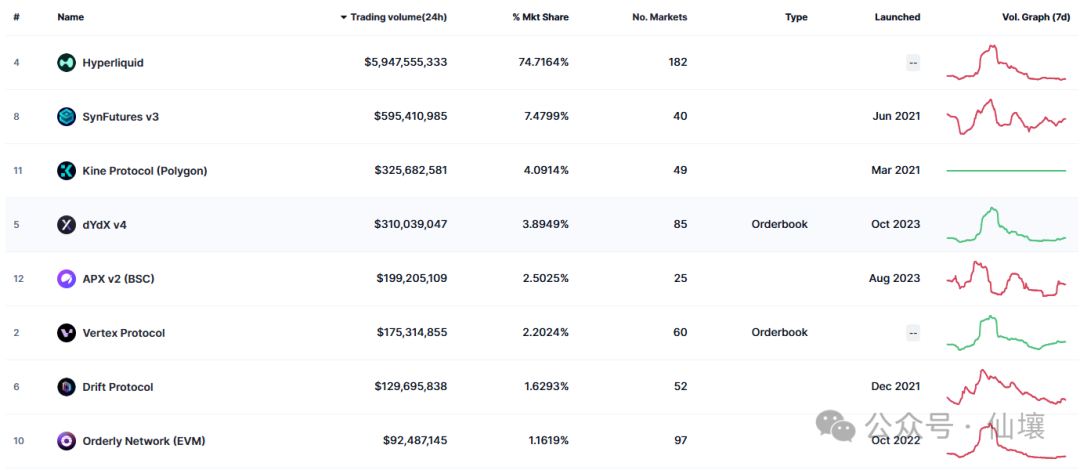
As of February 8, 2025, the $HYPE destroyed has reached 152,000 pieces, worth approximately US$3.426 million.
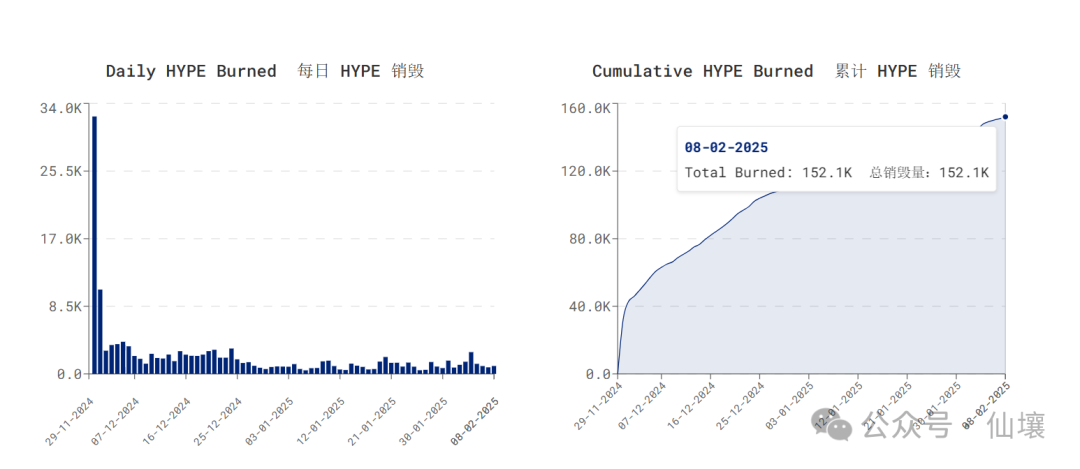
In addition to business revenue, Hyperliquid's infrastructure also empowers $HYPE. First of all, Hyperliquid L1 uses $HYPE as the Gas fee. Although it claims to provide gas-free transactions, it means that the user does not need to perceive the existence of Gas when trading. The system has included the Gas fee in the transaction fee, but this does not It means that Gas' design was cancelled at the bottom of the chain. In addition, with the construction of DeFi infrastructure in the ecosystem after HyperEVM is implemented, $HYPE may have specific scenarios such as lending and pledge.
Hyperliquid's controversy
Hyperliquid's controversy mainly focuses on two aspects. First of all, there is a fund security issue. Hyperliquid runs on an unopen source independent public chain, and trading on Hyperliquid is equivalent to depositing a Hyperliquid L1 bridge. Although Hyperliquid's bridge contract is audited by the well-known company Zellic, the nodes that match the bridge contract are The code is not open source, so there may be problems with this part of the code. In addition, Hyperliquid uses a multi-signature bridge, and its multi-signature nodes are likely to be controlled by the project party themselves.

Some projects that Zellic has provided audit services
In addition, Hyperliquid has been criticized for trading volume issues. The data of its open contract is also very exaggerated for a DEX.
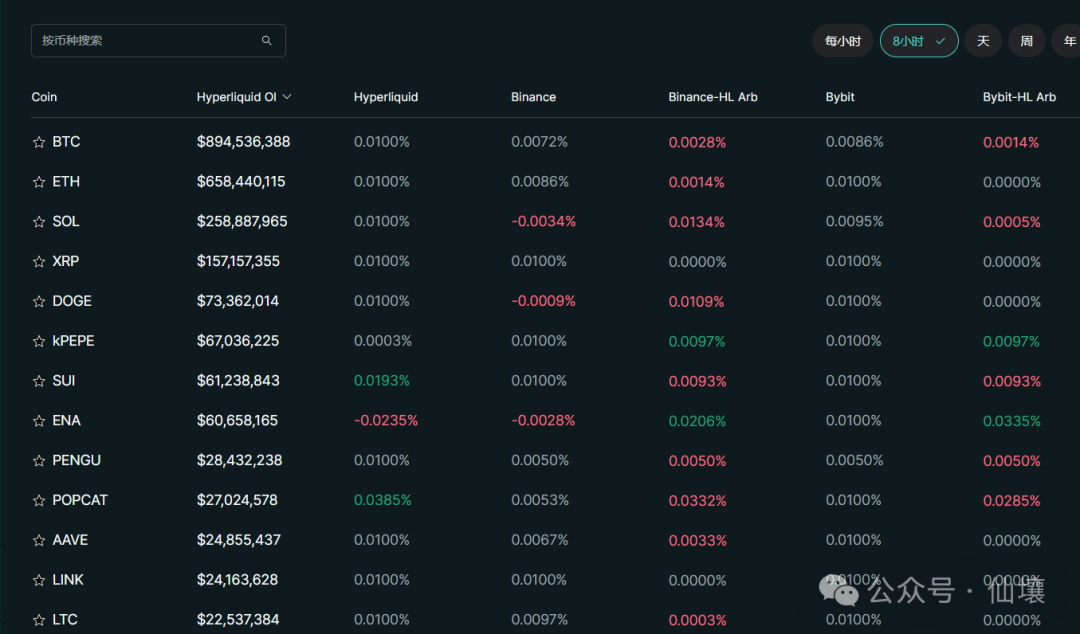
Hyperliquid\'s Funding Rate Panel
The picture shows the capital rate panel provided by Hyperliquid. Its original intention is to provide users with an intuitive capital rate comparison to facilitate users to conduct cross-market arbitrage, but it exposes some intriguing problems of Hyperliquid. We can see that the funding rates of most tokens are the same, keeping at the default 0.01%. Many people suspect that there is actually not so much actual transaction volume on Hyperliquid.
Because in a truly active market, supply and demand cannot be completely balanced, which will cause fluctuations in capital rates. When there are more buy orders than sell orders, the capital rate on the borrower will be lower, and when there are more sell orders, the capital rate will rise. The appearance of so many similar 0.01% means that Hyperliquid may be brushing orders, that is, increasing transaction volume through frequent clearing transactions and repeated orders to create the illusion of market activity.
Some traders in the market also reported that they had tried to do quantitative trading on Hyperliquid but failed because the actual trading depth was not enough. However, apart from user experience and inference, the issue of order brushing cannot be verified, because Hyperliquid is not open source, and we cannot obtain complete original transaction data by building nodes. In fact, there is no need to confirm this problem. We might as well think about another question: If order brushing is real, why should Hyperliquid do this? In fact, it's still a cold start problem.
Brushing orders is an effective means to solve the cold start of trading platforms. Referring to various Web2 products with significant network effects, various forms of brushing orders are far more common than Web3. To this day, e-commerce platforms such as Taobao and Tmall have about 30-40% of the transaction volume every year through order brushing; Youtube's video website often has automatic likes, comments, and followers that simulate user behavior. ;In popular games such as Peace Elite, among the 50 people in a game, you are probably the only one who is a real person, and the others are all AI.
As for the CEXs in Web3, no one dares to say that they have never brushed orders, so the problem of brushing orders is common and not as bad as everyone imagines. As we mentioned earlier, Hyperliquid's style is that the purpose of all actions is firmly serving to solve core problems. Even if there are some negative impacts on style evaluation, the order brushing is in line with its consistent style. There are actually only two core issues: cold start and user experience. In order to solve these two problems, it can even build a centralized and non-open source public chain, let alone order brushing?
Overall, Hyperliquid's product design basically revolves around a program: all product links and operational actions work together to get through the cold start period, giving users the experience of CEX, even if they are controversial, even if they give up something. Judging from the results, its strategy is very successful and worth reviewing and researching.


 jinse
jinse